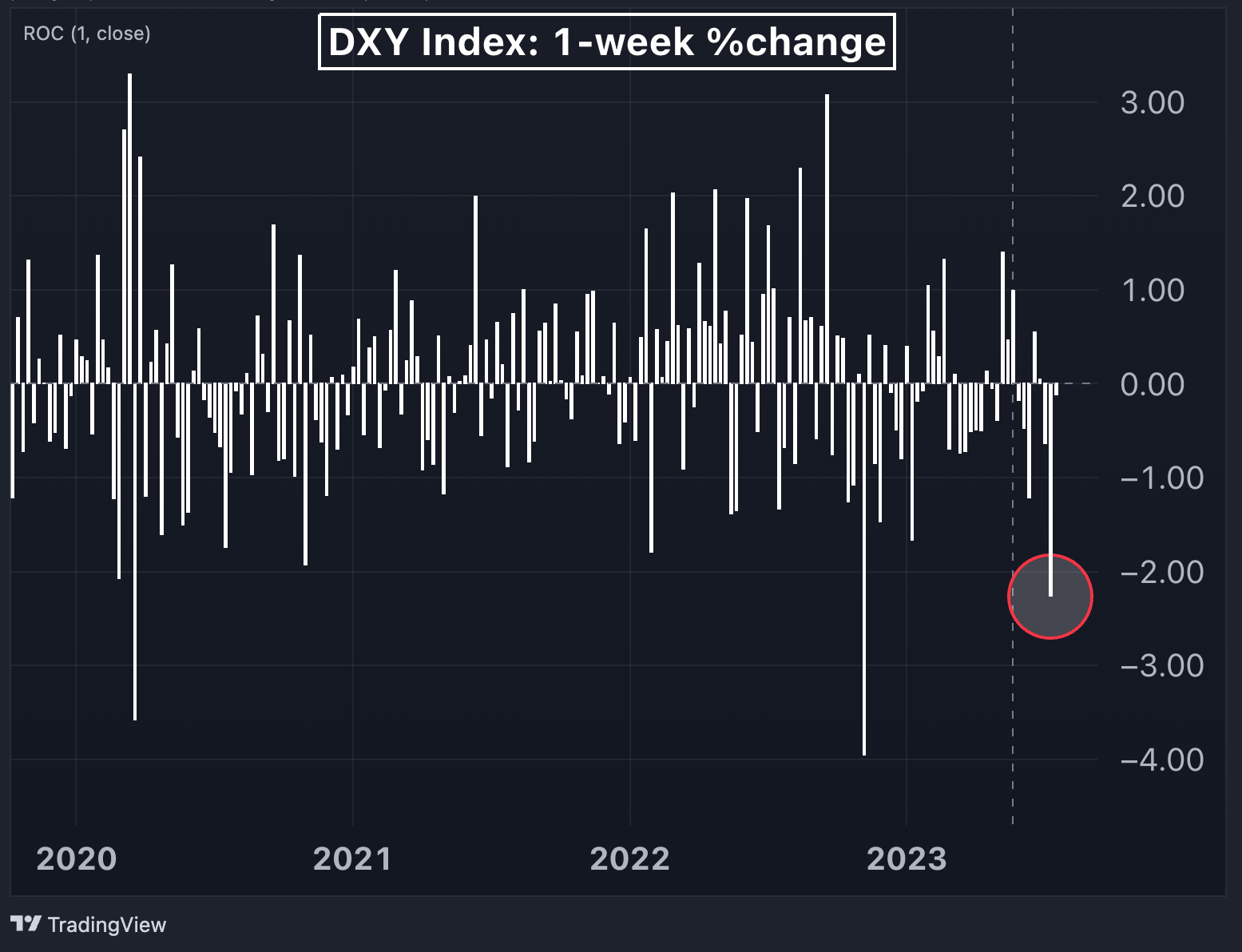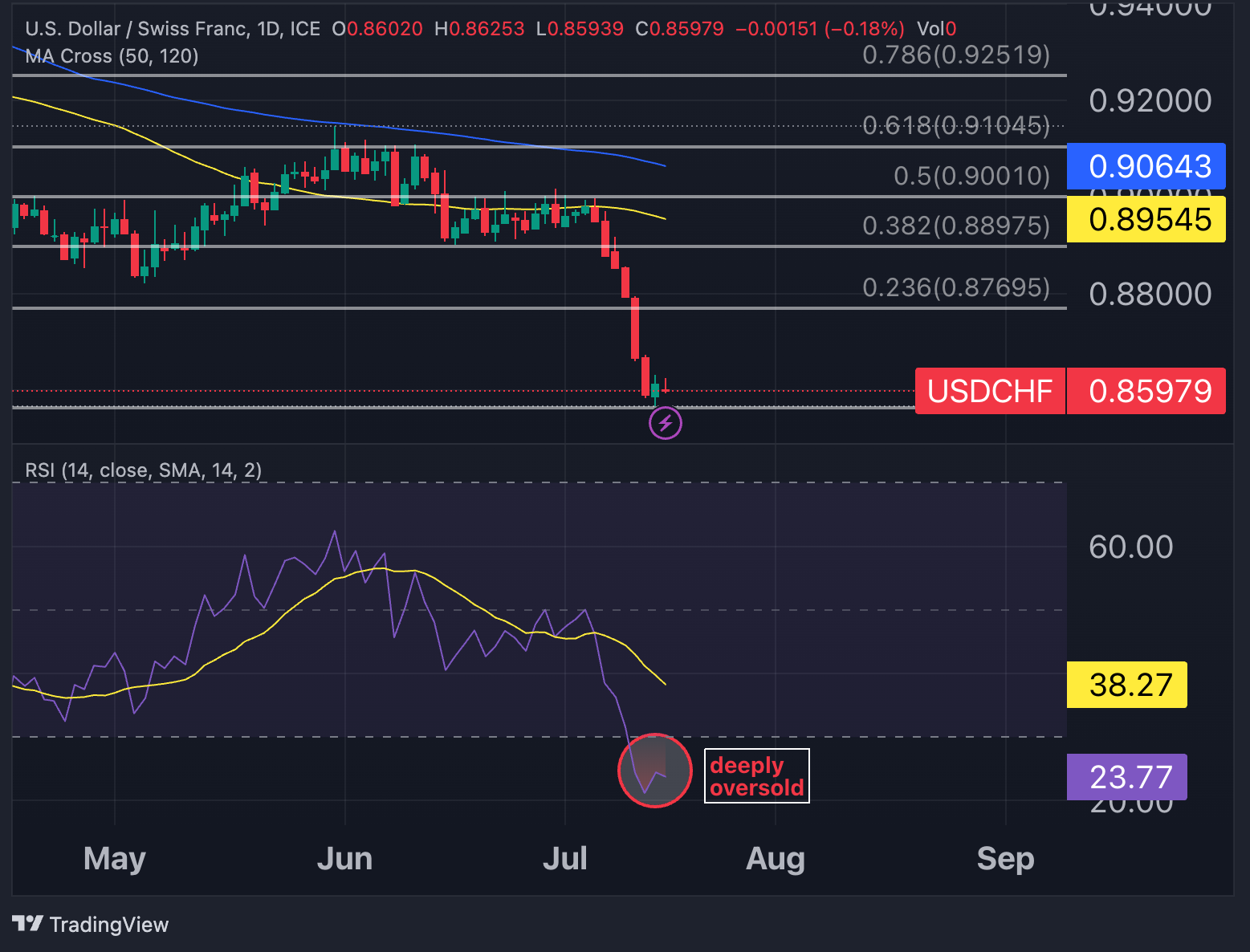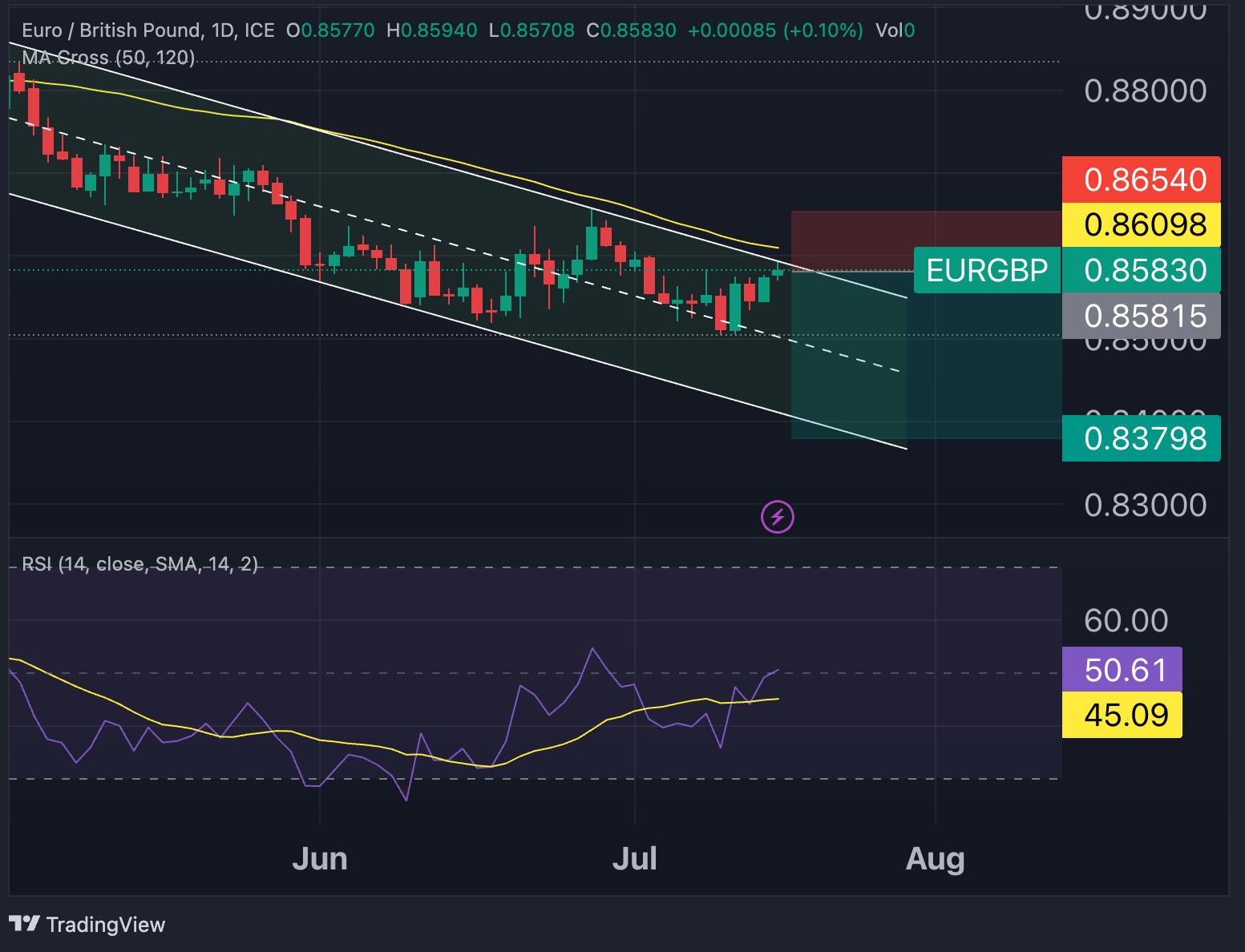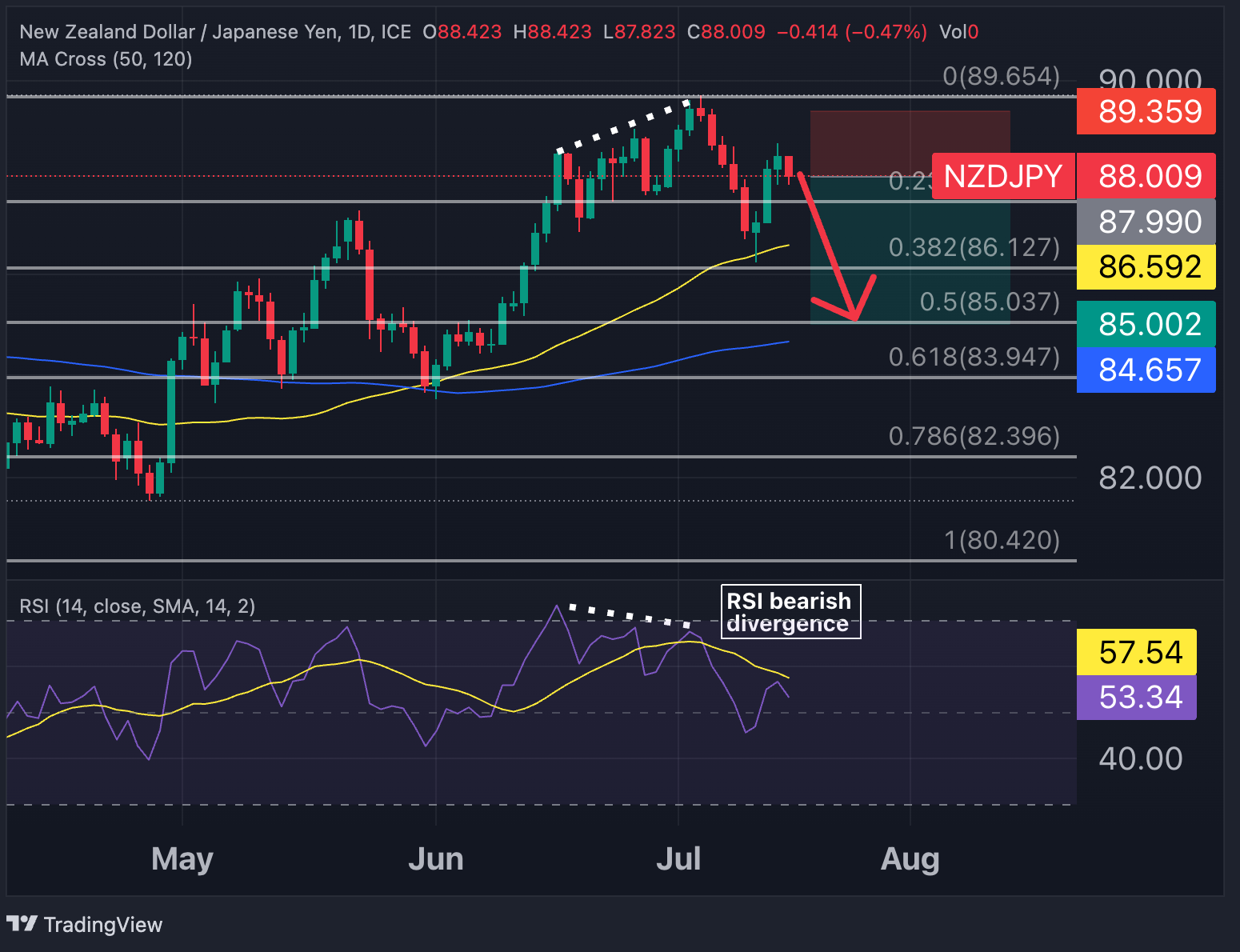Forex Trading: Is the Dollar Falling Apart? USD/CHF, EUR/GBP and NZD/JPY in focus.
Market Review: What Happened Last Week
The dollar had its toughest week of 2023, marking the third-worst performance in the past seven years. The DXY index dropped 2.3%, breaking below the significant 100 level to reach levels last seen in mid-April 2022.
A lower-than-expected CPI report played a significant role as U.S. annual inflation rate fell to 3%, extending a twelve-month decline to reach the lowest level since March 2021. Producer inflation also came in below expectations, marking the smallest annual increase in nearly three years.
With cooling inflation, market expectations on Fed rate hikes diminished. Although there is still a 96% implied probability of a Fed hike to 5.25-5.5% this month, the likelihood of a further increase by November is only around 28%.
The Norwegian krone (NOK) emerged as the best-performing G-10 currency for the third week in a row, gaining a whopping 5.3% against the USD. Following in its footsteps, the Swedish krona (SEK) strengthened by 5.2%. The Swiss franc (CHF) also had a remarkable week, rising 3% against the greenback.
The euro (EUR) recovered above 1.12, experiencing a 2.4% weekly increase against the dollar, reaching levels last seen at the end of February 2022 when the Ukraine conflict began. The pound (GBP) extended its ascent, driven by higher-than-expected wage growth, despite the British economy showing stagnation in the three months leading up to May 2023, and a higher-than-anticipated unemployment rate of 4%.
In terms of rate decisions, the Bank of Canada hiked 0.25% to 5%, as expected, while the Reserve Bank of New Zealand maintained rates at 5.5%, concluding the series of hikes initiated in October 2021.
The week began with disappointing economic data from China, as the second-quarter annual GDP growth came in at 6.3%, falling short of the 7.3% expectations.
Looking ahead, investors are eagerly anticipating retail sales data from the US and the UK, as well as inflation data from Canada, the UK, and Japan.
Forex Market: What To Expect This Week
United States:
- June's Retail Sales (Tuesday): Economists expect a 0.5% monthly increase in retail sales, with a 0.3% rise when excluding auto sales.
- June's Industrial Production (Tuesday): Industrial production is anticipated to remain flat, showing improvement from a 0.2% decline in May.
- Housing Stats (Wednesday and Thursday): Building permits are projected to rise to 1.5 million, reaching levels last seen in October 2022. Housing starts and existing home sales are expected to drop to 1.48 million and 4.2 million, respectively.
- Jobless Claims (Thursday): Initial unemployment claims are forecasted to increase slightly from 237K to 242K.
Euro Area:
- ECB Speakers (Monday): Christine Lagarde, Philip Lane, and other ECB officials will participate in the 9th ECB conference on central, eastern, and south-eastern European countries.
Other Data to Follow:
- UK Inflation Rate (Wednesday): The annual CPI rate is expected to decrease from 8.7% to 8.2% in June, while the Core CPI is projected to remain steady at 7.1%.
- Canada Inflation Rate (Tuesday): CPI is anticipated to drop from 3.4% to 3% in June, reaching its lowest level since January 2021.
- Japan Inflation Rate (Thursday): Consumer price pressures are expected to accelerate, reaching 3.5% year-on-year in June.
- Reserve Bank of Australia Meeting Minutes (Monday).
Chart Of The Week: Dollar Bears Return

New Trades For The Week
Long USD/CHF: Opened at 0.86; Take Profit at 0.89; Stop Loss at 0.85; Risk-reward ratio of 2.7

The U.S. dollar is in downward trend, but the recent drop against the Swiss franc may have been exaggerated.
The market appeared to overreact to U.S. inflation data, pushing USD/CHF to levels not seen since January 2015. The deeply oversold territory of both the daily and weekly RSI, at 24 and 25 respectively, suggests that caution is warranted for new bearish positions. This level of oversold RSI in the weekly chart has not been seen since August 2011, indicating a potential for a reversal as observed in previous abrupt bearish movements of USD/CHF.
Although there will be no remarks from Fed officials this week due to the blackout period prior to the Fed meeting, U.S. retail sales data could serve as a warning to dollar bears. However, any potential rebound in the dollar may be driven primarily by technical price action. Our view is that a rebound to 0.89 is likely as we approach the FOMC meeting next week. This level also corresponds to a 38.2% retracement from the low-to-high range of 2023.
Short EUR/GBP: Opened at 0.8579; Take Profit at 0.83.9; Stop Loss at 0.865; Risk-reward ratio of 2.8

Since the end of April 2023, the euro has been following a declining channel pattern against the pound. We believe there is still potential for further appreciation in the GBP before elevated interest rates break something in British the economy.
This week, the focus will be on the UK inflation rate, with the headline rate expected to ease to 8.2% and the core rate anticipated to remain steady at 7.1%. These inflation levels continue to justify a bold response from the Bank of England. Traders are anticipating a peak interest rate of 6.25% from the BoE, implying an additional 125 basis points of rate hikes by the first quarter of 2024.
Conversely, the market is starting to speculate that the ECB may opt for its final rate hike of the cycle in July, or at the latest, in September. The consumer price inflation rate in the Euro Area declined to 5.5% in June 2023, slightly below market expectations of 5.6%. The significant yield spread of nearly 200 basis points between 2-year UK bonds and 2-year German bonds adds to the downward pressure on EUR/GBP.
We favor a short trade with a price target at 0.838, aligning with the lower channel line. We would place the stop level at 0.865 if EUR/GBP manages to break above the 50-day moving average and the June 2023 highs.
Short NZD/JPY: Opened at 88; Take Profit at 85; Stop Loss at 89.35; Risk-reward ratio of 2.2

The New Zealand dollar (NZD) is expected to face significant pressure following disappointing Chinese data. This could lead to downside momentum in NZD-related pairs, with one attractive option being short NZD/JPY. Two potential scenarios supporting this trade include a risk-off sentiment in global equities and a hot inflation report in Japan.
From a technical perspective, the short trade is supported by a potential top formation on July 5th, marked by a bearish RSI reversal. While NZD/JPY reached its highest level since April 2015 at 89.69, the momentum indicator failed to reach new highs and began to trend lower, suggesting waning bullish momentum.
The 50-day moving average at 86.59 serves as the next price support, followed by 85, representing the 50% retracement of the 2023 high-to-low range and an attractive target for the short term.
Open trades from past weeks:
- Long CHF/JPY: Opened on June 19 at 158.58; TP at 171.62; SL at 152.5; P&L +1.6%.
- Long WTI spot: Opened on May 16 at $70.8; TP $80; SL $66.3; P&L +4.8%.
- Long EUR/JPY:
Opened on May 8, at 149.16, TP 160; SL 142; P&L +4.5%.
Curious about how the forex market operates? "Forex: How Does It Work?" is your first-step into understanding the mechanics of the foreign exchange market. In this exploration, we'll unravel the intricacies of forex trading, including the basics of currency pairs, the role of brokers, and the dynamics of price movements.




